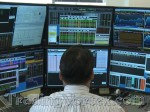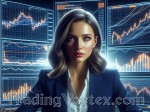Table Of Contents:
- Introduction to Forex Trading Fundamentals:
- Getting Started: Essential Concepts for Beginners:
- The Forex Market – An Overview:
- Currency Pairs – Foundation of Forex Trading:
- Fundamental Analysis in Forex Trading:
- Technical Analysis – Tools and Techniques:
- Risk Management Strategies for Beginners:
- Developing a Trading Plan:
- Psychology of Trading – Emotions and Discipline:
- Advanced Strategies for Pro Traders:
- Conclusion – Mastering the Forex Market:
Introduction to Forex Trading Fundamentals:
Understanding the Basics of Forex Trading for Beginners:
Hey there, fellow trader! Welcome to the exciting world of Forex trading. Whether you're just dipping your toes in the water or you've been navigating the currency markets for a while, understanding the fundamentals is key to your success.
Let's start with the basics. Forex trading, also known as foreign exchange trading, is all about buying and selling currencies with the aim of making a profit. It's like a global marketplace where currencies from all over the world are bought and sold 24 hours a day, five days a week.
Now, you might be wondering, "Why trade Forex?" Well, my friend, there are plenty of reasons why Forex trading is so appealing. For starters, it's the largest financial market in the world, with trillions of dollars being traded every single day. That means there's plenty of opportunity to profit, no matter what time of day you're trading.
But it's not just about the money. Forex trading also offers unparalleled flexibility. You can trade from anywhere in the world with an internet connection, allowing you to work on your own terms and schedule. Plus, with the ability to go long or short on any currency pair, you can profit in both rising and falling markets.
Why Forex Trading is Essential for Pro Traders?
Now, you might be thinking, "Why should I bother with Forex trading if I'm already a seasoned pro?" Well, my friend, let me tell you why Forex should be a cornerstone of your trading strategy.
First and foremost, Forex markets offer incredible liquidity and volatility. This means there's always plenty of action, giving you ample opportunities to capitalize on price movements and generate profits. Whether you're a day trader looking for quick gains or a swing trader seeking longer-term trends, Forex has something for everyone.
But it's not just about the excitement. Forex trading also provides valuable diversification for your portfolio. By adding currencies to the mix, you can spread your risk across different asset classes and potentially enhance your overall returns. Plus, with the ability to trade on margin, you can amplify your buying power and maximize your profit potential.
In short, whether you're a beginner just starting out or a seasoned pro looking to expand your horizons, understanding the fundamentals of Forex trading is absolutely essential. So buckle up, my friend, because we're about to embark on an exhilarating journey through the world of currency trading. Let's make some pips!
Getting Started: Essential Concepts for Beginners:
Exploring the World of Forex Trading Fundamentals:
Alright, my eager apprentice, let's dive into the exciting world of Forex trading fundamentals! As a beginner, stepping into the Forex arena might feel a bit like entering a bustling marketplace in a foreign land. But fear not, because I'm here to be your trusty guide through this exhilarating journey.
First things first, let's talk about what Forex trading is all about. At its core, Forex trading involves buying and selling currencies with the aim of making a profit. It's like a global game of chess, where traders from all corners of the globe strategize and maneuver their way to financial success.
Now, you might be wondering, "But why currencies?" Well, my friend, currencies are the lifeblood of the global economy. They're constantly in flux, affected by a myriad of factors such as economic data releases, geopolitical events, and central bank policies. And it's these fluctuations that create opportunities for savvy traders like yourself to profit.
Key Principles Every Beginner Should Know:
Alright, now that we've dipped our toes into the Forex pool, let's talk about some key principles that every beginner should know. Think of these as your trading commandments, the golden rules that will help steer you on the path to success.
- Rule number one: Knowledge is power. Before you even think about placing your first trade, take the time to educate yourself about the Forex market. Learn the basics of currency pairs, understand how to read price charts, and familiarize yourself with different trading strategies. Trust me, a little bit of knowledge can go a long way in this game.
- Rule number two: Practice makes perfect. Once you've armed yourself with knowledge, it's time to put theory into practice. But here's the thing: don't dive headfirst into the deep end of the pool just yet. Start off by opening a demo trading account, where you can trade with virtual money in real market conditions. It's the perfect way to hone your skills and build confidence without risking a single penny.
- Rule number three: Patience is a virtue. Rome wasn't built in a day, and neither is a successful trading career. Don't expect to become a millionaire overnight (unless you're exceptionally lucky, in which case, can I borrow some of that luck?). Instead, focus on the long game and be prepared to weather the inevitable ups and downs of the market.
Alright, my budding trader, armed with these essential concepts, you're well on your way to conquering the world of Forex trading. So strap in, stay curious, and remember: the journey is just as important as the destination. Let's embark on this adventure together!
The Forex Market – An Overview:
Navigating the Forex Market for Beginners:
Ah, the Forex market – a bustling hub of activity where fortunes are made and lost with the click of a mouse. For beginners, stepping into this world might feel a bit like being thrown into the deep end of the pool without knowing how to swim. But fear not, my intrepid explorer, because I'm here to guide you through the choppy waters of the Forex sea.
First things first, let's talk about the sheer size and scope of the Forex market. It's the largest financial market in the world, dwarfing all others in terms of trading volume and liquidity. With trillions of dollars changing hands every single day, it's a playground for traders of all shapes and sizes.
But "what exactly is the Forex market, you ask?" Well, think of it as a giant global marketplace where currencies from all over the world are bought and sold. From the mighty US dollar to the humble Swiss franc, every currency has its place in the Forex ecosystem.
Now, you might be wondering, "How does all this trading actually happen?" Well, it's all thanks to the wonders of modern technology. With the advent of the internet, traders can now access the Forex market from anywhere in the world with just a few clicks of a mouse. Whether you're sitting in a coffee shop in Tokyo or lounging on a beach in Bali, as long as you have an internet connection, the Forex world is your oyster.
Understanding Market Dynamics and Influencing Factors:
Alright, now that we've got the lay of the land, let's talk about what makes the Forex market tick. At its core, the Forex market is driven by supply and demand dynamics. When demand for a particular currency is high, its value goes up. Conversely, when demand is low, its value goes down. It's simple economics, really.
But of course, it's not just supply and demand that move the Forex market. Oh no, it's a complex tapestry of factors that can influence currency prices at any given moment. From economic data releases to geopolitical tensions to central bank policies, there's a myriad of variables that can impact currency values.
And let's not forget about the role of speculation in the Forex market. With so much money sloshing around, traders are constantly trying to anticipate future price movements and position themselves accordingly. It's like a high-stakes game of chess, where every move could mean the difference between victory and defeat.
So there you have it, my friend – a whirlwind tour of the Forex market. It's a vast and dynamic world, filled with endless possibilities and opportunities for those brave enough to venture forth. So strap in, stay nimble, and get ready to ride the waves of the Forex sea. It's going to be one heck of a journey!
Currency Pairs – Foundation of Forex Trading:
Demystifying Currency Pairs for Beginners:
Alright, my fellow trading enthusiasts, let's talk about the bread and butter of Forex trading – currency pairs. If you're new to this game, the concept of currency pairs might seem a tad confusing at first. But fear not, because I'm here to demystify this essential aspect of Forex trading for you.
So, what exactly is a currency pair? Well, it's pretty simple, actually. In Forex trading, currencies are always traded in pairs, with one currency being bought and the other being sold. Each pair consists of a base currency and a quote currency, and the value of the pair represents how much of the quote currency is needed to purchase one unit of the base currency.
Now, here's where it gets interesting. There are three main types of currency pairs: major pairs, minor pairs, and exotic pairs.
- Major pairs consist of the most widely traded currencies in the world, such as the EUR/USD, GBP/USD, and USD/JPY.
- Minor pairs, on the other hand, consist of less commonly traded currencies.
- While exotic pairs involve one major currency paired with a currency from a developing or emerging market.
How to Analyze and Trade Currency Pairs Effectively?
Alright, now that we've got the basics down, let's talk about how to analyze and trade currency pairs effectively. When it comes to Forex trading, there are two main methods of analysis: fundamental analysis and technical analysis.
- Fundamental analysis involves studying economic indicators, central bank policies, geopolitical events, and other factors that can influence currency values. It's like peering behind the curtain to see what's driving the market at a macro level.
- Technical analysis, on the other hand, involves studying price charts and using mathematical tools and indicators to identify trends and patterns. It's like reading the tea leaves of the market, looking for clues as to where prices might be headed next.
Now, here's the thing – there's no one-size-fits-all approach to trading currency pairs. Some traders swear by fundamental analysis, while others are die-hard fans of technical analysis. The key is to find a method that works for you and stick with it.
So there you have it, my friends – a crash course in currency pairs and how to trade them effectively. Whether you're a newbie just starting out or a seasoned pro looking to hone your skills, understanding the ins and outs of currency pairs is absolutely essential for success in the Forex market. So strap in, stay curious, and get ready to embark on the adventure of a lifetime!
Fundamental Analysis in Forex Trading:
Mastering Fundamental Analysis for Beginners:
Alright, my fellow traders, let's talk about one of the most powerful tools in your trading arsenal – fundamental analysis. Now, I know what you're thinking: "Fundamental analysis sounds fancy and intimidating." But trust me, it's not as complicated as it sounds. In fact, it's all about understanding the underlying factors that drive currency prices and using that knowledge to make informed trading decisions.
Now, you might be wondering, "But why bother with fundamental analysis when I can just rely on technical analysis?" Well, my friend, while technical analysis is great for identifying short-term trends and patterns, fundamental analysis provides the big picture perspective. It helps you understand the broader economic forces at play and anticipate longer-term trends in the market.
Using Economic Indicators and News Events to Inform Trades:
Alright, now that we've established the importance of fundamental analysis, let's talk about how to put it into practice. One of the key tools in the fundamental analyst's toolbox is economic indicators. These are data points released by governments and central banks that provide insight into the health of an economy.
Some of the most important economic indicators to watch out for include GDP growth rates, inflation rates, employment figures, and interest rate decisions. These indicators can give you valuable clues about the state of a country's economy and its currency's strength or weakness.
But it's not just economic indicators that you should pay attention to. Geopolitical events, such as elections, trade negotiations, and geopolitical tensions, can also have a significant impact on currency prices. That's why it's important to stay informed about what's happening around the world and how it might affect the currencies you're trading.
Alright, my friends, armed with the power of fundamental analysis, you're ready to take on the Forex market with confidence. Remember, Rome wasn't built in a day, and neither is a successful trading career. So be patient, stay curious, and keep honing your skills. The world of Forex trading is yours for the taking!
Technical Analysis – Tools and Techniques:
Introduction to Technical Analysis for Beginners:
Alright, my fellow traders, let's dive into the exciting world of technical analysis – the art of using charts and indicators to predict future price movements. Now, I know what you're thinking: "Technical analysis sounds complicated." But fear not, because I'm here to break it down for you in plain English.
Now, you might be wondering, "But why bother with technical analysis when I can just rely on fundamental analysis?" Well, my friend, while fundamental analysis provides the big picture perspective, technical analysis helps you zoom in on the nitty-gritty details. It's like having a magnifying glass that allows you to see the finer nuances of the market.
Essential Chart Patterns and Indicators Every Trader Should Know:
Alright, now that we've got the basics down, let's talk about some essential chart patterns and indicators that every trader should know. These are like the building blocks of technical analysis, the tools that will help you decipher the mysteries of the market.
First up, we have chart patterns. These are visual representations of price movements that can help you identify potential trend reversals or continuations. Some common chart patterns include head and shoulders, triangles, and double tops and bottoms. Learning to recognize these patterns can give you valuable insight into market sentiment and help you make more informed trading decisions.
Next, we have technical indicators. These are mathematical calculations based on price and volume data that can help you gauge the strength and direction of a trend. Some popular technical indicators include moving averages, RSI (Relative Strength Index), MACD (Moving Average Convergence Divergence), and Bollinger Bands. These indicators can be used in conjunction with chart patterns to confirm signals and increase the probability of success in your trades.
Alright, my friends, armed with the power of technical analysis, you're ready to tackle the Forex market with confidence. Remember, practice makes perfect, so don't be afraid to experiment with different chart patterns and indicators until you find what works best for you. The world of technical analysis is vast and ever-evolving, so stay curious, keep learning, and most importantly, have fun!
Risk Management Strategies for Beginners:
Importance of Risk Management in Forex Trading Fundamentals:
Alright, my fellow traders, let's talk about a topic that's near and dear to my heart – risk management. Now, I know what you're thinking: "Risk management sounds about as exciting as watching paint dry." But trust me, my friends, it's the single most important aspect of Forex trading fundamentals.
Here's the deal: the Forex market is a wild and unpredictable beast. Prices can swing wildly in the blink of an eye, leaving even the most seasoned traders scratching their heads in bewilderment. And that's where risk management comes in. It's like a safety net that helps protect you from the ups and downs of the market, ensuring that you live to trade another day.
But it's not just about protecting yourself from losses – although that's certainly important. Risk management is also about maximizing your profits and preserving your capital over the long term. By carefully managing your risk exposure and sticking to a disciplined trading plan, you can avoid the common pitfalls that trip up so many traders and set yourself up for success in the long run.
Practical Tips for Managing Risk and Preserving Capital:
Alright, now that we've established the importance of risk management, let's talk about some practical tips for putting it into practice. Here are a few strategies that every beginner trader should keep in mind:
- Set Stop-Loss Orders: One of the simplest and most effective ways to manage risk is to use stop-loss orders. These are orders placed with your broker that automatically close out a trade if it reaches a certain price level. By setting a stop-loss, you can limit your potential losses and protect your capital from catastrophic wipeouts.
- Diversify Your Portfolio: Another key principle of risk management is diversification. Instead of putting all your eggs in one basket, spread your risk across multiple currency pairs and asset classes. That way, if one trade goes south, you won't lose your shirt.
- Use Proper Position Sizing: It's important to size your positions appropriately based on your risk tolerance and account size. A good rule of thumb is to risk no more than 1-2% of your account balance on any single trade. This helps ensure that a string of losses won't blow up your account and leave you high and dry.
- Stay Disciplined: Finally, perhaps the most important aspect of risk management is discipline. Stick to your trading plan, resist the temptation to chase after big wins or revenge trade after losses, and always keep your emotions in check. Remember, trading is a marathon, not a sprint, so pace yourself accordingly.
Alright, my friends, armed with these risk management strategies, you're well on your way to becoming a savvy and successful Forex trader. So remember, trade smart, stay disciplined, and may the pips be ever in your favor!
Developing a Trading Plan:
Crafting a Winning Trading Plan for Beginners:
Alright, my trading comrades, let's talk about one of the most important tools in your arsenal – your trading plan. Now, I know what you're thinking: "A trading plan? Who needs that when I've got my gut instinct and a lucky rabbit's foot?" But trust me, my friends, a trading plan is like a roadmap that guides you through the treacherous terrain of the Forex market and helps you stay on course to your destination – profitability.
Now, you might be wondering, "But what should I include in my trading plan?" Well, that's where the fun part comes in. Your trading plan should be as unique as you are, tailored to your own trading style, risk tolerance, and financial goals. But here are a few key components that every trading plan should include:
- Trading Goals: Start by defining your short-term and long-term trading goals. Do you want to make a certain amount of profit each month? Are you aiming to achieve a specific return on investment over the next year? Setting clear and achievable goals will give you something to strive for and keep you motivated during the inevitable ups and downs of trading.
- Trading Strategies: Next, outline your trading strategies. Will you be a day trader, a swing trader, or a position trader? Will you focus on technical analysis, fundamental analysis, or a combination of both? Define your entry and exit criteria, as well as any specific indicators or patterns you'll be looking for.
- Risk Management Rules: Perhaps the most important aspect of your trading plan is your risk management rules. This includes setting stop-loss orders, determining your position size, and establishing maximum risk limits for each trade. Remember, preserving your capital is paramount – without it, you won't be able to trade another day.
Setting Clear Goals and Strategies for Long-Term Success:
Alright, now that we've got the basics of your trading plan down, let's talk about setting clear goals and strategies for long-term success. You see, my friends, trading is not a sprint – it's a marathon. And like any marathon runner will tell you, success comes from careful planning, disciplined execution, and unwavering determination.
- First and foremost, be realistic with your goals. Sure, we'd all love to make a million bucks overnight, but let's face it – that's not going to happen. Instead, focus on setting achievable goals that align with your skills, resources, and risk tolerance. Remember, slow and steady wins the race.
- Next, stick to your trading plan like glue. It's all too easy to get sidetracked by shiny new strategies or the latest hot tip from a friend. But resist the temptation to deviate from your plan – it's been carefully crafted based on your own research and experience, and veering off course could lead to disaster.
- Finally, stay flexible and adaptable. The Forex market is a dynamic and ever-changing beast, and what works today might not work tomorrow. Be willing to adjust your strategies and goals as needed based on market conditions, economic events, and new insights you gain along the way.
Alright, my friends, armed with your trusty trading plan, you're well on your way to becoming a master of the Forex market. So go forth, trade boldly, and may the pips be ever in your favor!
Psychology of Trading – Emotions and Discipline:
Overcoming Psychological Challenges for Beginners:
Alright, my fellow traders, let's talk about the elephant in the room – the psychology of trading. Now, I don't mean to scare you, but the Forex market can be a bit of an emotional rollercoaster. One minute you're riding high on a wave of euphoria after a winning trade, and the next you're plunging into the depths of despair after a string of losses. Sound familiar?
The truth is, trading is as much a mental game as it is a technical one. And for beginners, mastering your emotions can be one of the biggest challenges you'll face. Fear, greed, FOMO (fear of missing out) – these emotions can wreak havoc on your trading decisions if you're not careful.
So, how do you overcome these psychological challenges and keep your emotions in check? Well, my friends, it's all about self-awareness and self-discipline. Take the time to recognize your emotional triggers and learn to respond to them in a calm and rational manner. Remember, trading is a marathon, not a sprint, so don't let short-term emotions cloud your long-term judgment.
Cultivating Discipline and Emotional Control in Trading:
Now, let's talk about discipline – the secret sauce that separates the winners from the losers in the world of trading. You see, my friends, discipline is like the North Star that guides you through the stormy seas of the Forex market. It's what keeps you focused, patient, and resilient in the face of adversity.
But cultivating discipline is easier said than done, especially when faced with the lure of easy money and the fear of missing out on lucrative opportunities. So how do you stay disciplined in the face of temptation?
- Well, it all starts with having a solid trading plan and sticking to it religiously. Set clear rules for yourself, and don't deviate from them no matter what.
- Another key aspect of discipline is risk management. By limiting your risk exposure and sticking to your predetermined risk management rules, you can avoid making impulsive decisions based on emotion and protect your capital from unnecessary losses.
- And finally, don't be too hard on yourself when things don't go according to plan. Losses are a natural part of trading, and no one – I repeat, no one – wins 100% of the time. Learn from your mistakes, dust yourself off, and come back stronger and wiser than before.
Alright, my friends, armed with the power of self-awareness, self-discipline, and emotional control, you're well on your way to becoming a master of the Forex market. So remember, stay calm, stay focused, and may the pips be ever in your favor!
Advanced Strategies for Pro Traders:
Transitioning from Beginner to Pro – Advanced Techniques:
Ah, my fellow trading aficionados, it's time to take our trading game to the next level – the realm of advanced strategies for pro traders. Now, if you've made it this far, give yourself a pat on the back because you're about to embark on a journey that will separate the amateurs from the pros.
Transitioning from beginner to pro is like leveling up in a video game – it requires dedication, skill, and a willingness to push beyond your comfort zone. But fear not, my friends, because I'm here to guide you through the treacherous waters of advanced trading techniques with the wisdom of a seasoned trader and the enthusiasm of a lifelong learner.
So, what exactly are these advanced techniques that separate the pros from the rest of the pack? Well, my friends, they come in many shapes and sizes, but they all share one thing in common – they require a deep understanding of market dynamics, a keen eye for detail, and the ability to think on your feet.
Scalping, Swing Trading, and Position Trading Strategies:
Alright, let's dive into the nitty-gritty of advanced trading strategies, shall we?
- First up, we have scalping – the art of making lightning-fast trades to capture small price movements. Scalping requires lightning-fast reflexes, razor-sharp focus, and nerves of steel. It's not for the faint of heart, but for those who can master it, the rewards can be substantial.
- Next, we have swing trading – a more relaxed approach that involves holding trades for days, weeks, or even months to capture larger price movements. Swing traders look for opportunities to ride the ebb and flow of the market, jumping in when the timing is right and riding the wave to profitability. It requires patience, discipline, and a knack for spotting trends before they happen.
- And finally, we have position trading – the longest time frame of them all, where trades can last for months or even years. Position traders take a big-picture approach, focusing on macroeconomic trends and long-term fundamentals to inform their trading decisions. It's a slower-paced strategy, but for those who have the patience and the foresight, the potential rewards can be astronomical.
So there you have it, my friends – a whirlwind tour of advanced trading strategies for pro traders. Whether you're a scalper, a swing trader, or a position trader, the key is to find a strategy that aligns with your personality, your goals, and your risk tolerance. So strap in, stay nimble, and get ready to take your trading game to new heights!
Conclusion – Mastering the Forex Market:
Reflecting on the Journey:
Well, my fellow traders, we've reached the end of our epic journey through the wild and wonderful world of Forex trading fundamentals. From the humble beginnings of understanding currency pairs to the advanced strategies of pro traders, we've covered a lot of ground together. But before we part ways, let's take a moment to reflect on the lessons we've learned and the adventures we've had along the way.
Embracing the Learning Curve:
First and foremost, let's give ourselves a round of applause for having the courage to embark on this journey in the first place. Trading Forex is no small feat – it requires dedication, discipline, and a willingness to embrace the learning curve. So whether you're a beginner just starting out or a seasoned pro looking to sharpen your skills, pat yourself on the back for taking the plunge and diving headfirst into the exciting world of Forex trading.
Navigating the Ups and Downs:
Along the way, we've encountered our fair share of ups and downs – the thrill of a winning trade, the frustration of a losing streak, and everything in between. But through it all, we've persevered, learning valuable lessons with each twist and turn of the market. Remember, my friends, trading is a journey, not a destination, and every setback is an opportunity to learn and grow stronger.
Building a Foundation for Success:
As we bid farewell to our journey together, let's not forget the importance of building a solid foundation for success. From mastering the basics of Forex trading to developing advanced strategies, we've laid the groundwork for a prosperous trading career. But the journey doesn't end here – it's just the beginning of a lifelong pursuit of knowledge, growth, and mastery in the Forex market.
Final Words of Wisdom:
So as you venture forth into the vast and ever-changing landscape of the Forex market, remember these words of wisdom: stay curious, stay disciplined, and above all, stay true to yourself. Trading is as much an art as it is a science, and success ultimately comes down to finding your own unique approach and staying true to your vision.
Farewell, Until We Meet Again:
And so, my friends, it's time to bid farewell. Whether you're embarking on your first trade or refining your strategies as a seasoned pro, remember that you're never alone on this journey. Reach out to your fellow traders for support, guidance, and camaraderie, and together, we'll navigate the highs and lows of the Forex market with courage, resilience, and a healthy dose of humor.
Until we meet again, happy trading, and may the pips be ever in your favor! 🍀


















 TradingVortex.com® 2019 © All Rights Reserved.
TradingVortex.com® 2019 © All Rights Reserved.